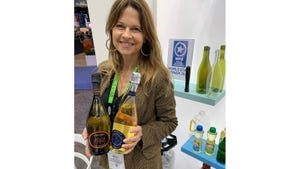High CARB diet for fuel tanks
July 1, 2006
With the fifth-largest economy in the world, California''s state government decisions often carry weight beyond its borders.
That has certainly been the case with the California Air Resources Board''s (CARB) new fuel-emission standards, which are affecting plastic fuel-system material choices and technologies in everything from cars to boats and lawnmowers. Thermoforming sheet stock supplier Spartech (St. Louis, MO) sees opportunity where others have seen a headache, promoting its Low E Poly ("e" for emissions) multilayer extruded sheet as a thermoforming solution for the marketplace. As part of its Green Initiative, Spartech has invested $15 million in two European production lines used to make sheet for fuel tanks for the Volkswagen Passat, which are twin-sheet thermoformed by Visteon in Europe.
By applying twin-sheet thermoforming, where two halves are formed and then brought together for hollow geometries normally achieved in rotomolding or blowmolding, Visteon is able to enclose ancillary fuel-system components like gauges and pumps within the tank. Outside the tank, additional connections for such systems present leakage opportunities; inside the tank, the systems are fully contained.
"Our customers are out banging on the doors of all the OEMs," Spartech''s Director of Marketing Howard Kenney says, "saying basically the thermoforming channel has a solution."
The sheet stock for VW is supplied from Spartech''s Donchery, France operation in the Ardennes region, and Kenney estimates that the company will run 15 to 20 million lb of the material this year. Spartech has also added Low E capabilities at its Portage, WI plant, with plans for this output to target nonautomotive products in the agricultural, motor sports, and marine markets, among others.
Kenney says one customer has three programs being tooled right now, with 45 quotations pending, indicative of a technology that is earth and ledger friendly. "Everybody''s been looking at green as a compliance type of thing," Kenney says, "something you have to do. We wanted to turn it around and say for a lot of reasons, not the least of which is it''s the `right thing to do,'' there are market opportunities out there if you develop products that speak to being green."
11-layer fuel tanks?
Spartech''s sheet goes up to seven layers, but according to automotive plastics consultant Paul Tres, founder of Engineering Technology Services (Bloomfield Hills, MI), that might not be enough as standards become even stricter, which could change the technologies and materials used to make fuel tanks.
"Right now you need around six to seven layers," Tres says, "those are the average vehicles being built in the U.S. I would say in the next three to five years, we will be talking about 11 layers."
Tres says plastics fuel tanks, whether they''re made via thermoforming, blowmolding, or rotomolding, are far from a given. In Europe he estimates that 95% of tanks are plastic, but in the U.S. (75%), and Japan (35%), metal still has a significant presence, which could be augmented by tougher emissions codes. According to Tres, an entire fuel system, over the course of a year, shouldn''t lose more than 2g of gasoline through permeation.
Tres also points out that thermoformed tanks can present some issues, since they involve two halves being joined together, with an interruption in the barrier structure possible at the seam, unlike blowmolded fuel tanks.
TI Automotive (Warren, MI), a global supplier of fuel systems, recently added to and built a new facility for the manufacturing of blowmolded fuel tanks in the American south, adding a $2.3-million 6500-ft2 addition to its Hanil USA subsidiary in Tallassee, AL, and investing $30-million in a 145,000-ft2 plant in Hartwell, GA.
The company uses two different Kautex Maschinenbau blowmolding lines to create the tanks and filler lines. According to Corporate Communications Manager Domenic Milicia, tanks are extrusion blowmolded with a 120-ton double-clamp Kautex KBS2-241D. The machine has a throughput of 1100 kg/hr, and it makes six-layer tanks from high-density polyethylene (HDPE), EVOH for barrier, and an adhesive for the tie layers, with capacity in place for one million tanks a year. Filler pipes are made using a 40-ton Kautex KBS3-D machine, which features robotic parison manipulation to maneuver a parison into a mold to create complex, twisting shapes. The filler lines are a seven-layer product, made up of HDPE, EVOH, adhesives, and conductive HDPE.
Tony Deligio [email protected]
Contact information
Engineering Training Services Inc. | |
Kautex Maschinenbau | |
Spartech Corp. |
You May Also Like


